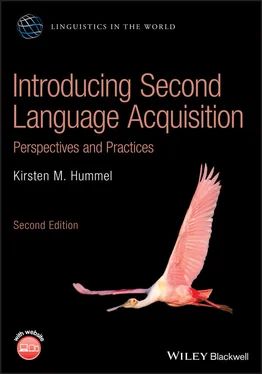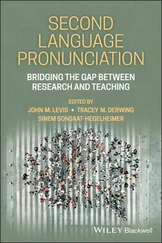object permanence
The understanding that an infant gains during the latter part of the first year that objects continue to exist even though they may no longer be visible.
On the other hand, L2 learners, by definition learning the target language beyond infancy and early childhood, have already gone through a number of fundamental cognitive stages. Basic cognitive concepts such as the notion of object permanence and means‐end awareness have been attained. In addition, their cognitive development allows them metalinguistic awareness, meaning that they are able to reflect on language as a tool for thought or learning. Due to this awareness, L2 learners come to the language learning task equipped in a very different way from the L1 acquirer. As one example, some L2 learners may and often do prefer to learn through explicit exposure to the grammatical rules of the target language. Individuals with an analytical approach to learning may prefer to use logical reasoning skills to acquire parts of the L2. In L1 acquisition, young children do not yet have the same metalinguistic capacity. They are often incapable of recognizing that words are arbitrary labels for objects. Ask a toddler to suspend her intuitions and call her pet cat “dog” and you are likely to be greeted with puzzled incomprehension. Or try to get a two‐year‐old to focus on the form of his words in order to use the correct past tense form when he is not at the stage for doing so and his metalinguistic shortcomings will probably become rapidly evident. In the following dialogue Tommy ignores his mother's correction:
metalinguistic awareness
Ability to reflect on language as an object.
Tommy:
“Daddy goed.”
Mother:
“No, Tommy, Daddy wentto work.”
Tommy:
“Daddy goed work.”
Once children are exposed to literacy skills in school, they develop metalinguistic skills and become increasingly able to reflect on and manipulate aspects of linguistic form.
Language learning in practice
In his entertaining book The tipping point: How little things can make a big difference (2000), Malcolm Gladwell reports that during an episode of Sesame Street, when the character Big Bird changes his name to “Roy” because he does not like the fact that his name describes him physically (a “big bird”), the producers discovered children watching the episode appeared to fail to understand the plot: they were unable to attach another name to Big Bird. Gladwell points out that this illustrates the principle of mutual exclusivity that young children follow – that objects (and big birds) normally only have one label – but it also reveals their metalinguistic limitations, i.e. their inability to reflect on language as an object.
Another important difference that distinguishes L2 from L1 acquisition is that the older learner already has one linguistic system to fall back on when necessary. This contributes to affective and emotional differences. Learning an L1 is essential to satisfying a person's basic needs for food, as well as ensuring other basic care and security. For the older learner of an L2, one linguistic repertoire is already in place to ensure efficient communication to satisfy basic needs and desires. Furthermore, for the older L2 learner, having to acquire another set of language skills can lead to feelings of alienation from the strongly embedded native language and culture. While the child's crucial first events and emotions are accompanied by communication in the L1, for individuals learning an L2 those deeply embedded feelings are already linked with their native language and as a result similar feelings are less tightly linked to the L2. Related to this is the occurrence of anxiety in situations where speakers have to resort to a not fully mastered L2.
The fact that L2 learners by definition already have another linguistic system to rely on leads to other differences. L2 learner language illustrates the ubiquitous phenomenon of transferor interferencethat occurs when aspects of the L1 are used in the L2, whether in the form of pronunciation, vocabulary, or grammar. For instance, a common error made in English by French speakers is to use the present perfect tense in contexts requiring the simple past, such as “I have studied last night” instead of “I studied last night,” most likely due to the fact that French requires the structurally similar past form, conjugated with “to have” to describe a past action (e.g. J'ai étudié hier soir ). Obviously, and by definition, the young child learning her L1 does not have another language that can interfere in the learning process. Note that for the L2 learner a second language system can both hinder (interfere) and help (where structures across languages are similar) in the learning process.
transfer
Influence of the L1 in using the L2, or vice versa.
interference
Influence of L1 in the L2 when it leads to an error, or vice versa.
From the perspective of the social context, expectations are very different in the two cases. The child learning to speak his first words is not expected to carry on a conversation easily with interlocutors, and every new utterance may be met with joy and encouragement by his entourage. For the older L2 learner, particularly adults learning a language in a new country, social expectations may be relatively high: it is expected that an adult should normally be able to communicate accurately and fluently. Even when there is considerable tolerance for second language learners on the part of members of the target language group, adult learners themselves are used to being able to communicate more or less flawlessly in their L1, and having to stumble and hesitate in another language can be a frustrating and intimidating experience.
Another significant difference between learning the first language and learning a second language is the actual context of learning. A young child normally learns his first language in the home, as well as through interactions with caregivers outside the home. For the older learner, school age and above, most often L2 learning is at least partly carried out in an instructional setting, such as in a local school classroom or private language school. Teaching strategies and materials may differ considerably from one classroom to another, contributing to additional learning outcomes among learners. Instructional settings generally use a structured presentation format; certain linguistic aspects are presented before others. Due to time and contextual limitations, importance may be given to learning some linguistic features rather than others. The choices that an instructional setting implements are likely to impact learners in different ways, depending on the extent to which the methodology is in synchrony or not with a given individual's learning preferences.
Related to differences in learning contexts is the amount of exposure time allotted to the language. The young child learning her L1 is commonly exposed to a significant amount of that language: feeding, bathing, and social interactions may primarily or exclusively take place in the L1. For the second language learner, apart from cases of total immersion in the target language environment, L2 exposure may be limited to as little as an hour once a week, or several hours a day in the case of more immersion‐type instructional settings; still, the absolute exposure time is likely to be significantly less in the case of the second language learner compared to a child's L1 exposure.
As pointed out earlier in the discussion of L1 acquisition, in many societies, although not all, children learning their native language are exposed to particular linguistic and paralinguistic (prosodic) adaptations; this has been referred to as CDS or caregiver talk. In contrast, older children and adults learning a second language are not systematically exposed to a significant amount of adaptation in the L2 input they hear. Some studies do report that native speakers make some speech adjustments, such as slowing the flow of speech when conversing with someone they know is a new language learner, or using conversation devices to negotiate meaning. However, CDS used with children learning their L1 appears to be a much more predictable phenomenon.
Читать дальше












